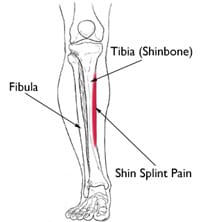
In fact, why not cover a bunch of different runner’s injuries?
What are shin splints?
First, let’s be clear about what a shin splint is not. The leg, between the knee and the ankle, consists of two bones – the fibula and tibia – which make up the shin area. If you are experiencing a sharp pain that feels like you cannot walk normally whenever you press down on your heel, you should get checked out. That feels much less like a shin splint and much more like a stress fracture, which is a small crack in the bone that can be exacerbated by the same things that cause shin splints… but more on that later.
To be short, shin splints are far more likely to be a muscle issue, not a bone issue. When an overworked muscle swells or tears, it pulls away from and pushes against other parts of the bone, causing the pain. This is why “shin splints” also enjoy another name, “medial tibial stress syndrome.”
What causes shin splints?

How do I prevent shin splints?
Because shin splints are generally identified as the pain that comes from swelling of the muscles, not the bone, the best way – in my humble opinion – to avoid developing shin splints is to be proactive in your training. Stretch properly before and after your run, so that you can avoid developing tight calf and thigh muscles. Perform strength training exercises that prepare your lower body for the beating that comes with leaping up from the ground on one leg and slamming back down into it on another leg, at a fast pace.Muscle supports your bones in completing tasks, so having more muscle can only make life [and running] easier for your legs.
Also, pay close attention to the way your foot lands while you’re running. Are you rolling your ankle too far outward or too far inward? This contributes to the “imbalanced use of muscles” that I spoke of, earlier, and can contribute to perpetual shin splints if it goes on uncorrected.
Spend some time analyzing your last run. Did the surface change? Did you go from a dirt trail to concrete? Was it more hilly than you generally expect? Was it cobblestone, and you were struggling to get through it? You will definitely need to train a little more rigorously for changes in terrain, but that’s after you have incorporated strength training in your regular routine and removed any hills or weird changes in terrain from your trail.
What do I do about the shin splints I have now?
When it comes to any running injury, your best friend is RICE:
Rest. Spend a day or two off of your legs. There’s nothing worse than making an injury worse, hobbling around and using your muscles out-of-balance even more.
Ice it down. What’s an ice pack to a boss? (A lot, if you ask me. I hate ice.) Numbing it down will also help it heal a bit more if, for no other reason, it’ll require you to sit down and stay put.
Compress it. Get yourself a good ace bandage or a shin brace, and wear that whenever you have to walk while it heals. It hurts to walk on sore muscles, and you feel like you have to limp or walk on the balls of your feet so as to avoid aggravating the sore area. Providing support via a brace or bandage makes a huge difference.
Elevate it. Let gravity be your friend. Elevate your legs and let the blood flow, making sure the affected regions get what they need.
What did I leave off? How do you deal with shin splints?

8 comments
I’ve had shin splints before. Besides rest, it is important to have the right shoes to prevent them in the first place. Once I got properly fitted, they stopped occurring. Others I know with it found that when it’s time to replace their shoes, the pain comes back. Remember to change shoes based on either high mileage OR months of running. The exact number depends on how often you run in them.
See, a lot of the running coaches I’ve spoken with specified that shoes shouldn’t be “correcting” or “preventing” these kinds of things, that you should be correcting or strengthening your muscles so that you can accommodate the activity. But, on the other hand, worn down shoes can absolutely contribute to developing shin splints… so I don’t know. I’ve checked my books and none of them mention the shoes thing, but I know there is a market for “buy THESE shoes to fix your problem,” instead of “fix your problem… oh, and buy these shoes!”
I also know that there’s a lot of disagreement on that point, but I just wanted to be clear on where I stand with it.
Most shin splints are caused by heel striking when running. Changing your running strike to a midfoot strike will nearly eliminate shin splints.
To help alleviate the pain of shin splints, the best exercise is to do toe raises. Stand on your heels, and lift your toes up.
To balance it out you can do calf raises, by lifting up and standing on the ball of your feet.
You can make it harder by doing these on an edge, stair or sidewalk corner.
Word. I wrote more about that here.
This happened to me once in the past. For me it was because I started my running season running at the pace I ended my previous season. Bad idea. I needed to build my pace back up to that level. The pain was so bad I ended up going to an ortho. At the end of the day I just needed to back off and ease back in.
I actually remember another time I had them. I switched from regular shoes to Vibrams. That was another “ease into it” situation. Muscles that hadn’t been used in years were being worked.
Shin Splits are caused due to over usage. I use to get them all of the time until stopped running everyday. Now I only run every other day. It also depends on how heavy you are!
SHIN SPLITS SUCKS booooooo I sooo pissed that i can’t run how i want to my goal was to run my first 5k in 2013 and these shin thingys prevent me from training how i would like (sigh) because of my splits I only get to run on fri which i now dub my run day and I have to go hard because it’s the only day i can without my splints hurting, i damn near run myself into the ground every fri lol…i’m getting faster but it’s a slow process i’m nowhere where i should be but i’ll take everything you said and try those. I’m determined to run my 5k this year without stopping!!
Comments are closed.